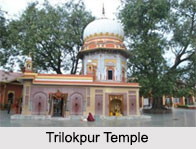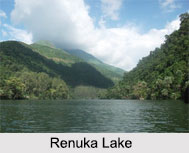 Located in the south-eastern part of Himachal Pradesh in the Sirmaur district is the town of Nahan. It lies at an average elevation of 932 metres. This town used to be the capital of the former princely state of Sirmur and is now currently the location of the Indian Army Special Forces Training School.
Located in the south-eastern part of Himachal Pradesh in the Sirmaur district is the town of Nahan. It lies at an average elevation of 932 metres. This town used to be the capital of the former princely state of Sirmur and is now currently the location of the Indian Army Special Forces Training School.
History of Nahan
The city of Nahan was founded in the year 1621 by Raja Karam Prakash. It is known that traditionally saints and princes are linked with the origin of this place. It is believed that this town derives its name from a sage called Baba Banwari Das, who was also known as Nahar, and used to live in the same site. The word Nahar means "don"t kill" and the town takes its name from an incident when the king tried to hunt a lion and the saint said Nahar, asking the king not to kill the animal. Another version is that Nahar means lion in Sanskrit. At the place where Nahan is, there used to be an abundance of lions so it was named Nahar. Latter it was called Nahan, which is distortion of the word Nahar. The quaint town today, is dotted with gardens, temples and a manmade lake.
Demographics of Nahan
Nahan is a Municipal Corporation city which is divided into 13 wards for which elections are held every 5 years. As per report released by the Census India 2011, the Nahan Municipal Council has a population of 28,899 of which 15,225 are males while 13,674 are females. Population of children with age of 0 to 6 years is 2952 which is 10.21% of total population of Nahan. In Nahan Municipal Council, female sex ratio is of 898 against state average of 972. Moreover child sex ratio is around 871 compared to Himachal Pradesh state average of 909. Literacy rate in Nahan city is 91% higher than state average of 83%. In Nahan, the male literacy is around 94% while female literacy rate is 88%.
The Nahan Municipal Council has a total administration of over 6,679 houses to which it supplies basic amenities like water and sewerage. It also authorizes to build roads within the city limits and impose taxes on properties coming under its jurisdiction.
Climate of Nahan
The city of Nahan has a Mediterranean type of climate, which is also known as dry summer climate. This type of climate is characterized by rainy winters and dry summers. The average annual temperature in Nahan is about 21° C. The city receives an average of 2,174 mm of rainfall annually.
Precipitation is the lowest in April, with an average of 14 mm. The greatest amount of precipitation occurs in August, with an average of 697 mm. At an average temperature of 29° C, June is the hottest month of the year. The lowest average temperatures in the year occur in January, when it is around 11° C.
 Places of Attraction in Nahan
Places of Attraction in Nahan
The lakes, temples and parks of Nahan are marked as major sights of tourism. Listed below are few of the major attractions in Nahan.
Suketi Fossil Park: Also known as the Shivalik Fossil Park, is a notified national geo-heritage monument. The park displays life-size fibre reinforced plastic models of pre-historic animals whose fossil skeletons were unearthed here. The park is the first of its kind in Asia to be developed at the actual discovery site of fossils. Recently, a two and a half feet long ivory was found in sand soil, which was about 150.000 years old based on carbon dating.
Trilokpur Temple: Built by Raja Dip Prakash in the year 1573, Trilokpur is a place of great religious importance. The temple of the goddess Mahamaya Bala Sundri attracts lakhs of devotees from all over northern India. During the Navratra, a fair is held twice a year during the months of April and October.
Dhaula Kuan: Also known as Dhaulakaun, it is known for its sprawling orchard consisting of citrus plants and mangoes and a fruit canning factory of various kinds of juices, jams, pickles and canned fruits. A little away from Dhaula Kuan is Kastasan Devi temple where Raja Jagat Singh defeated the advancing army of Rustam Qadir Rohilla in a great battle. Their victory is commemorated in the Devi Temple, built in gratitude by the Raja. Dhaula Kuan also has a research station of H.P., KVV where useful research on tropical fruits is carried out.
Paonta Sahib: Founded by Sikh Guru, Guru Gobind Singh, Paonta Sahib is one of the major industrial towns in Himachal Pradesh. It is a significant place of worship for Sikhs, hosting a great Gurdwara, named Gurudwara Paonta Sahib which is situated on the banks of the Yamuna River.
The other places of interest are the Renuka Lake, Jagannath Temple, Lakshmi Narayan Temple, Giri Nagar, and a number of other lakes and temples.
 Fairs and Festivals in Nahan
Fairs and Festivals in Nahan
Nahan is a city of traditions. The city commemorates some popular festivals to celebrate the ending season of monsoon and includes a number of pilgrimages. Among these some popular ones are the pilgrimage of Moni- Mahesh which is located at Chamba valley of Himachal Pradesh. This area further includes some more prominent places like the village of Malan, whose inhabitants are the followers of Lord Shiva. Instead of worshipping the idols this community believes in different rock formations and places their offerings in the open air.
The community of Nahan celebrates some uncommon festivals like Vaaman Dwadshi, when 52 cult images of Gods are carried in procession to the Jagannath Temple, where they are floated ceremoniously in a pool and are restored at midnight to their niches. It is celebrated towards the end of monsoon. Then there is the Gugga Peer Festival, which is dedicated to Gugga- a folk deity of Rajasthan. This festival is celebrated to mark the honour of Gogaji or Gugga.
Visiting Information on Nahan
The nearest airport is at Chandigarh at a distance of about 81 km. By roadways, Nahan is well connected to Himachal Pradesh and the rest of India via National Highway 7 and National Highway 907A. Railway stations of Barara, Ambala, Chandigarh and Kalka are near Nahan. Yamunanagar is also another railway station located close to the city of Nahan.






